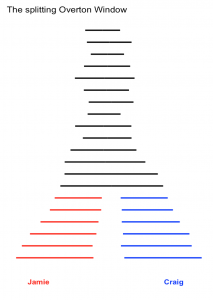If you want to appear intelligent when discussing something about public policy, you could do worse than uttering the phrase “Overton Window”. The Overton Window, “invented” by one Joseph Overton, suggests that there is a “range of policies acceptable to political mainstream”.
And so you frequently have political commentators talking about the Overton Window “shifting” whenever a new political idea (or person) comes to the fore. This was bandied about much when Modi became Prime Minister of India, or when Trump became President of the US, or when Jeremy Corbyn became the Labour Party leader.
While “shifting Overton window” is something you come across rather often in policy discourse, my argument is that with the rise of subscription media, the Overton window is not shifting as much as it is “splitting”. In other words, we now have not one but two Overton Windows.
Without loss of generality, let us call them the “Jamie Overton Window” and the “Craig Overton Window”. Since both the twins are right arm fast bowlers, it doesn’t matter which brother is associated with which Overton Window.
So how did we get here, and what does it mean for us?
We started with the classic Overton Window. Let’s assume that all politics can be reduced to one axis (if we do a Principal Component Analysis of political views, the principal axis is certain to account for a large share of the variance, so this is not a bad assumption). So the Overton Window can be referred to by a line which the shifts.
As long as the world was “ruled by mainstream media”, this Overton Window kept moving back and forth, expanding and contracting, but it remained united. And then with the start of subscription ad-free media (maybe a decade or decade and half ago), the Overton Window started expanding.
The “left media” (that’s a convenient term isn’t it?) started admitting stuff that was left to the then Overton Window. The “right media” started admitting stuff that was to the right of the then Overton Window. And so over time, the Overton Window started expanding. And things can’t get into the media Overton Window unless they’re part of the mainstream political Overton Window.
The thing is that as the media became subscription-heavy and hence biased, political ideas that were once on the fringe now got a voice. And so the Overton Window got larger and larger.
Until a point when it got so unwieldy that it split, giving rise to Jamie and Craig. The image on the right is an approximate illustration of what happened.
And once the Overton Window split, there was no looking back. They started moving away from each other well-at-a-faster-rate. The Jamies could not come to terms with the policies of the Craigs, and vice versa. Political analysts and commentators started getting associated with the Jamie and Craig camps.
For a while, a few commentators continued to write for both sides, but the extreme fringes, which were getting more and more extreme, started overreacting. “How can we have someone who has written 10 articles for Craigs write for us”, the Jamies asked. “Most of our commentators are Craigs, so we might as well become a Craig newspaper”, the other side reasoned.
And that’s where mainstream media is going. The Overton Window has split down the middle. Crossing this gap is considered a crime worse than crossing the floor in Parliament.
Sadly, it is not just media that is getting Jamie and Craig. Mainstream politics reflects this as well, and so across countries we get political opponents who just cannot talk to each other, since everything one says is outside the Overton Window of the other.
Maybe the only way this can end is by going across axes, or inventing a new axis even. With the current spectrum politics, there is no hope of the two Overton Windows coming to meet.
The consequences of splitting are dire for electoral validity. As the windows split and go further apart, people have to pick camps and agree with all beliefs from their corresponding window. This leads to single issue voters – if you like guns, vote Republican; if you want to slow down climate change, vote democratic. But that means that fringe issues which cause emotional reactions can drive significant voting, rather than fringe. This can mean that solutions that poll well are political dead ends (like sensible gun control which has 60-80% approval). As such political rewards are in chasing fringe-issues along emotionally charged patterns (e.g. debating transgender toilet assignments when actual issues caused by it are largely uncommon and most people will never come across it).
I suppose these are still early days of our societies adapting to online information flow. By the time our kids are up, there might be a new paradigm where people don’t trust what they see and hear. Widespread acknowledgement and certification of facts might become routine and people might even seek it. A new but stable social order might be in place of what we have.